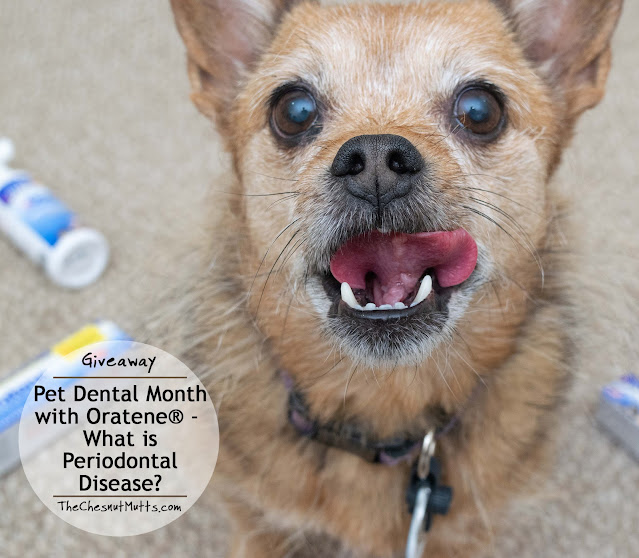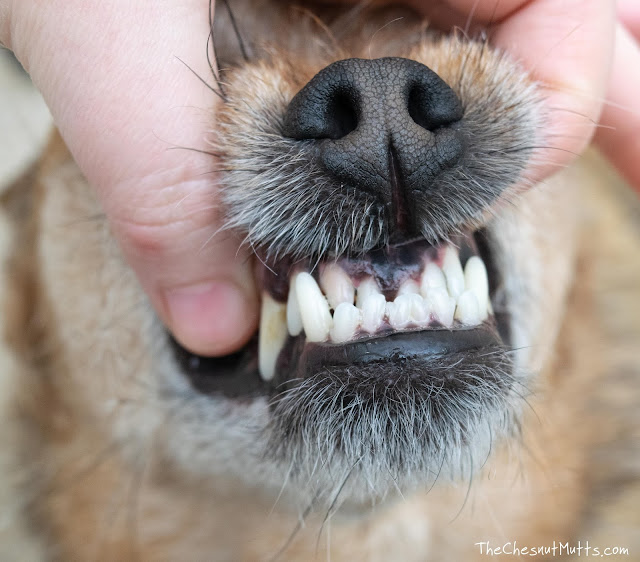What is periodontal disease?
 |
| (Photo from knappvet.com) |
Periodontal disease is when the gum tissue surrounding a tooth becomes inflamed and infected and the roots of the tooth start to deteriorate. Besides causing bad breath, the infection can spread to other parts of your dog's body and cause issues with the liver, kidneys, and even the heart. It is really easy for us pet owners to miss the signs before it is too late.
What causes periodontal disease?
Just like in humans, dogs can get plaque and tartar buildup. Plaque is what we recognize as that slimy film of bacteria that we feel on our teeth and begins forming right after eating, while tartar (also called calculus) is actually hardened plaque that sticks to the tooth itself. The rough texture of tartar allows for more plaque to buildup and it kind of snowballs from there.
Besides hardened tartar on the teeth, some common signs that a vet check is in order include: bad breath, not wanting to eat, trouble eating, chewing on one side of the mouth, and seeing blood on chew toys.
So what can we do to prevent our pet from getting periodontal disease and keep our pet's dental health in tip top shape?
First and foremost, take your dog for routine vet checks. Your veterinarian can assess their mouth and recommend if professional dental cleaning or any tooth removal is needed.
Brush your dog's teeth! Best case scenario, brush them once or twice a day, but even I brush once every few weeks and that's not enough on its own. The best bet is to use an enzymatic toothpaste and soft-bristled brush and use circular motions along the teeth paying extra attention to the back teeth. If your dog doesn't like their teeth brushed, there are finger brushes that can help get them used to the new sensation, and you can even use a cloth to rub the teeth as well.
Use a dental gel after brushing. I love to use Oratene's Toothpaste Gel after brushing really well to try to get in the crevices and hard to reach places in my dogs' mouths. The gel actually eliminates that bad bacteria and inhibits plaque from forming. We have a super in-depth blog post about the enzyme system that are featured in all Oratene products so be sure to check it out.
Learn how we use Oratene's Toothpaste Gel:
Provide toys for them to chew. Any kind of chew toy that provides mechanical action can help scrape away plaque and tartar. There are many toys that are specifically made for dental health that feature the use of rope and textures like nubs.
Giving your dog chews regularly can also help in the same way as toys when it comes to chewing. Some dental chews can provide additional benefits like reducing plaque and tartar in addition to the mechanical action. In addition, there are also specific dental diets that use large kibble pieces to make the dog or cat slow down and chew their food longer.
A great hands-off approach would be to add a dental additive to your pet's water. Oratene's Water Additive was actually recommended by my veterinarian many years ago and we have been using it ever since. It's super easy as all you have to do is put a couple of squirts of the liquid into your dog's water bowl regularly.
Also, If your dog has irritated gums or signs of Periodontal disease, using Oratene's Dental Gel can provide some relief to those areas. This gel provides maximum enzyme contact to get more of that good bacteria in the gums while removing the bad bacteria.
And finally, everyone needs some way to freshen that breath! Oratene's Breath Freshener spray does just that with their advanced enzyme technology. This is a great way to quickly rid bad bacteria in your dog's mouth, but please note any new breath smells as a possible infection. Be sure to make an appointment with your vet!
In a nutshell...
- Periodontal disease is the inflammation and infection of the gums surrounding a tooth which can cause the roots of the teeth to deteriorate and cause issues with other parts of the body as well.
- This is caused by an increased amount of bacteria in the mouth causing plaque and then hardening to become tartar. Once that bacteria goes under the gum line is when we start to see symptoms of periodontal disease like bone loss.
- To prevent this disease and keep your dog's dental health in check there are many methods which I recommend doing as many as possible: vet checks, brushing your dog's teeth, dental gel, chew toys, chews/dental chews, water additive, using an oral gel as needed, breath freshener spray.
Achieving great dental health for your pet is difficult but not impossible. From my experience, it takes a combination of different methods, products, and care to get on track.
What do you do to improve your pet's dental health?
Let us know in the comments below!













I brush her teeth!
ReplyDeletemia2009(at)comcast(dot)net
They go for regualr vet visits and dental cleanings. I also give them lots of chew toys.
ReplyDeleteI would love to try this toothpaste on Layla as I have read so much good reviews on it
ReplyDeleteWe brush their teeth and have their teeth cleaned. Barbara
ReplyDeleteJust what the vet tells me .
ReplyDeleteI brush my dogs teeth daily. I started when he was a puppy to get him used to the toothbrush. He loves having his teeth brushed, he thinks the toothpaste is a treat.
ReplyDeletei brush their teeth every nite, we go to a dental specialist several times a year and they get their teeth cleaned 1-2 times a year professionally.
ReplyDeleteI would love to try this for my furbaby we have been trying so many things for bad breath!
ReplyDeleteBrushing frequently.
ReplyDelete